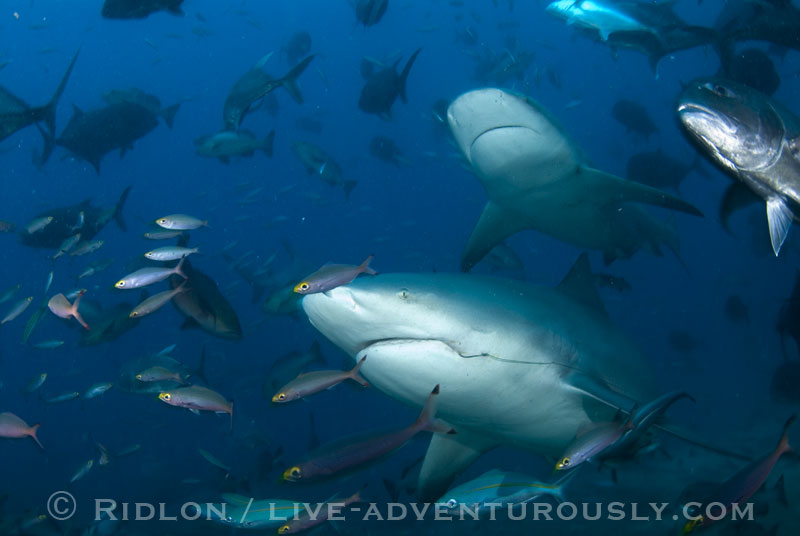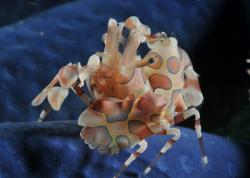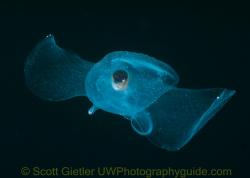Two of the Best Shark Diving Destinations in the World
I love diving with sharks. Given my nickname – Sharkman – that’s probably no surprise. Back in the 90’s, I had the awesome opportunity to live and work at a dive operation in French Polynesia for a couple of years. That’s where I was introduced to shark diving for the first time. Sharks are relatively abundant in French Polynesia and are somewhat protected by local tribal customs and beliefs. French Polynesia is also the birthplace of shark feeding or using bait to attract sharks during a dive and is the first place I ever witnessed that phenomena. Sharks are ephemeral, elegant and powerful and I take every opportunity I can to dive underwater with them. Among other reasons, numerous shark species are seriously endangered and I believe that through safely diving with sharks and using the imagery we capture constructively, we create more shark proponents.

Shark diving at night at Cocos Island. Nikon D200, Nexus housing, Tokina 10-17mm @ 15mm, F5.6, 1/60th, ISO 500.
Mantagirl and I recently returned from a Fiji & Cocos Island scouting trip and at first glance those two dive destinations may not seem to be on the way from one another. If the diving is good enough though, we can make any dive destinations on the way from one another so that’s what we did on this trip: Missoula, Salt Lake, L.A., Nadi-Fiji, L.A., Orlando, Atlanta, San Jose-Costa Rica/Cocos Island, Orlando, New York, Minneapolis, Missoula. While I wouldn’t recommend that particular flight itinerary, it was definitely worth the travel because there is spectacular shark diving in both Fiji and Cocos Island. In fact, these are two of the best shark dives in the world, especially for underwater photography.
2019 Update: Best Shark Diving in the World: Top 5 Destinations
Shark dives in Beqa Lagoon, Fiji
While Fiji is best known for its richly colorful soft corals, there is a lot more to Fiji diving than that. As we shared in the destination guide for Fiji, the country is a collection of over 300 islands and displays an incredible amount of marine diversity – stunning and healthy hard corals, dramatic drop offs, good macro, pelagic life and shark diving.
Aqua-Trek, based in Pacific Harbor has been nurturing a shark dive on the south coast of the main island of Viti Levu for about 10 years. I’d heard about it a number of times but never made it down to check it out until this trip. Big kudos to Aqua-Trek for working with local communities and the Fijian government to create marine protected areas at and around the shark diving site. They bill the dive as the #1 shark feed dive in the world and after doing numerous shark feed dives all over the world I agree.

Shark diving at Beqa Lagoon, Fiji. F8, 1/90th, ISO 200.
When we pulled up to the shark dive site, I was very surprised to not see any sharks swimming around. At an established shark feed diving site like this one, the engines of the dive boat produce a Pavlovian response and are like a big dinner bell ringing. But Aqua-Trek conducts the feed deeper down on the reef and this seems to keep the sharks down there. Its not that they couldn’t come shallower, they just don’t. Even after descending, it was a minute before I began to see large shapes with pronounced dorsal fins swimming just above the bottom.
So what makes this the #1 shark feed dive in the world? First, the diversity; you can see bull sharks – and I mean BIG ones, Pacific nurse sharks, Pacific lemon sharks, white tip reef sharks, silvertip sharks, oceanic black tip sharks, black tip reef sharks, gray reef sharks and even tiger sharks. It’s almost impossible to see this many shark species on one dive anywhere. Second, the action; there’s an incredible amount of it with over 50 individual sharks participating and dozens swooping in for the bait. At times, it seems like there are sharks everywhere because at times, there are. Even after the bait is gone, many of the sharks stay around and you have the opportunity to swim with them along the reef. I came up from that dive saying – kick ass.

Fiji - one of the best shark diving destinations. F5.6, 1/40th, ISO 100.
Pacific Harbor is on the south coast of the big island, Viti Levu, and Aqua Trek operates out of the Pearl South Pacific Resort. We were staying a 45 minute boat ride away on Beqa Island at Beqa Lagoon Resort. Every Friday, Beqa Lagoon Resort offers the shark dive as an optional two tank morning excursion. The Beqa Lagoon boat meets the Aqua-Trek boat at the site and Aqua-Trek conducts the feed. One thing I’m not really crazy about is that the feeder from Aqua-Trek hand feeds the sharks and there’s talk of one of the guys being a “shark whisperer.” I think that ultimately, that’s a great way to get accidentally bitten. And when that happens, it will be bad PR for the sharks.
Shark dives at Cocos Island, Costa Rica
Then it was off to Costa Rica to dive Cocos Island for a completely different shark diving experience with just as high a kick ass factor. Cocos Island is a UNESCO World Heritage Listed Site which means it’s kind of a national park of the world. This designation is given to places of special cultural or natural importance to the common heritage of humanity.
Cocos Island is also known as the island of the sharks and the night dive at Manuelita Island is something special. Here, in a completely natural environment, large numbers of white tip reef sharks get together at night to pack hunt on the reef. Whereas this behavior has been witnessed at other places at Cocos Island, nowhere is it as dramatic as at Isla Manuelita. At Manuelita Coral Gardens, the coral bottom is literally a moving mass of white tip reef sharks – hundreds of them. One of the night dive rules – don’t come within six feet of the bottom – is for the simple reason that if you got too close to the bottom, sharks would probably bump into you; there’s just that many. As the pack gathers in size and a sleeping fish is found, all hell breaks loose and it’s a sudden free for all with a winner-takes-all devouring the unfortunate sleeper. And then the pack streams down the reef with a sense of sudden urgency to find its next unaware prey. It was observing this behavior play out across several dives that I realized white tip reef sharks, at least these ones, were generally lousy hunters. In fact, I wondered how the white tips even survived as I watched a number have fish bump right off their snouts or swim right underneath them and remain unscathed. But every night is all you can catch fish buffet night at Isla Manuelita.

Shark diving at Cocos Island. Nikon 60mm, F5.6, 1/125th, ISO 200
Cocos Island is a live aboard only dive destination as there are no accommodations on this wild island for touristos – only a small ranger station and a lot of amazing waterfalls. The Undersea Hunter group has been running dive trips to Cocos for over a decade and has three boats that do 10 day trips with 7 days of diving: Sea Hunter, Undersea Hunter and Argo.
Two awesome shark dives and I was able to produce the imagery to match. Over time, I’ve learned a lot about shooting sharks and continue to learn more each time I dive with them. It’s a never-ending process but here are some thoughts after diving in Fiji and Cocos Island about underwater photography of sharks.
In the open water at Cocos island, looking for sharks. Photo by Enrico Dinca.
Techniques and strategies for underwater shark photography
-
Take a minute to understand the pattern that the sharks swim during a shark dive. They are animals of habit and especially at feeds will swim a pattern. Position yourself appropriately.
-
Listen carefully to the pre-dive briefing; you will likely hear important information on both safety and shark behavior.
-
Pull your head out of your viewfinder. Do this for both safety reasons and so you can observe the action around you and see compositions developing.
-
Picture in your mind before the dive the image you want to capture. Shark dives are often chaotic and it will help if you start with a plan.
-
Blast away! Shoot a ton of exposures because a lot of what you can capture during a shark dive, especially from a composition standpoint, is a matter of serendipity. I use a 16GB card so even shooting in RAW, I can be a spendthrift with my # of exposures.
-
Be ready to shoot at a second’s notice. Some compositions will come and go that quickly.
-
Dial your strobes down if you can so they recycle faster. I use a pair of Inon Z240s and try to dial them from -1 to -2 if conditions allow me to do that and still get a correct exposure. At that power, they recycle in less than a second so I can get multiple shots at a passing shark.
-
Shoot with manual power settings on your strobes instead of TTL. Because of the shark’s counter shading and quite often the fact that you are shooting against a darker background, TTL has the tendency to overexpose the white underside of a shark.
On the night dive shark feed, I had to play around with a combination of F-stop, shutter speed, ISO and strobe power to get the effect I wanted. I started with F8, 1/125, ISO 200 with strobes near full but this didn’t give me the eeriness I was going for. The sharks were well illuminated, almost too much so and the background was nearly black. I changed to F5.6, 1/60, ISO 400 instead and dialed my strobes way down. These settings both created an eeriness that I was seeking and also allowed the image to pick up the illumination of the surrounding dive lights (see the photo at the beginning of this article). To me, the dive looked like a writhing mass of sharks on the bottom that was being illuminated by beams coming from UFO’s in a dark sky. I wanted to convey that sense in my imagery.
Other great shark destinations
Be sure to check out shark diving in Cuba, a new top-secret shark diving spot.
Further Reading

RECOMMENDED ARTICLES
SUPPORT THE UNDERWATER PHOTOGRAPHY GUIDE:
The Best Service & Prices on u/w Photo Gear
 Visit Bluewater Photo & Video for all your underwater photography and video gear. Click, or call the team at (310) 633-5052 for expert advice!
Visit Bluewater Photo & Video for all your underwater photography and video gear. Click, or call the team at (310) 633-5052 for expert advice!
The Best Pricing, Service & Expert Advice to Book your Dive Trips
 Bluewater Travel is your full-service scuba travel agency. Let our expert advisers plan and book your next dive vacation. Run by divers, for divers.
Bluewater Travel is your full-service scuba travel agency. Let our expert advisers plan and book your next dive vacation. Run by divers, for divers.
































